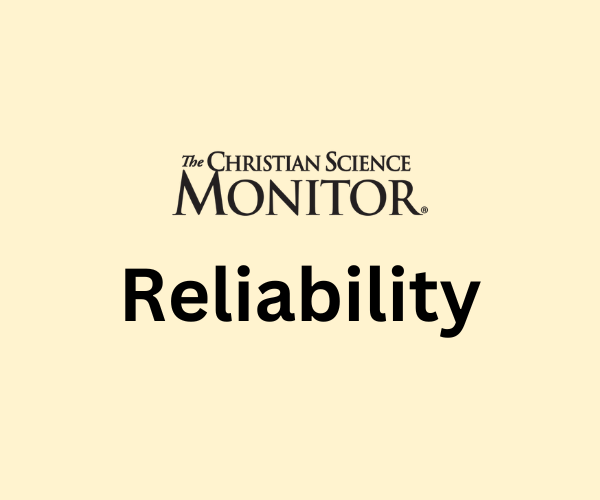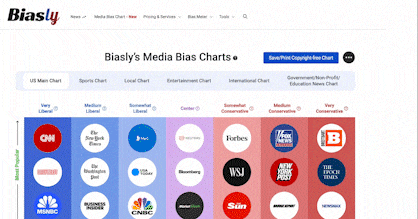
For 116 years, the Christian Science Monitor has built a reputation as a trusted and respected source of news and analysis, known for its commitment to accuracy and unbiased reporting. It provides in-depth coverage of global events and issues with a unique focus on solution-oriented journalism. Unlike many news outlets prioritizing sensationalism, the Christian Science Monitor emphasizes context and comprehensive analysis, encouraging readers to understand the complexities of various issues.
There are concerns about the selection of sources used, as it may reflect a particular viewpoint. Furthermore, some articles need to represent opposing views or provide essential context sufficiently. At Biasly, we are committed to evaluating the reliability and accuracy of all media outlets. At Biasly, we aim to assess the reliability and accuracy of all media outlets. Let’s investigate the reliability and accuracy of the Christian Science Monitor.
Does Reliability Matter?
Reliability, in general, refers to how trustworthy or accurate information, or in this case, a news source is. If we consider this definition, it quickly becomes clear why reliability is important in media sources. If we can’t trust the things we read then there isn’t much of a point in continuing to consume content from that source, after all. So how exactly can we gauge the reliability of a news source anyways?
There are several potential measures of reliability to look out for when trying to determine whether a media source is reliable or not. Red flags for an unreliable article can include the presence of wild unsubstantiated claims, facts dependent on other unreliable sources, heavy use of opinionated language, and more. Some indicators of a reliable news source, on the other hand, include things like:
- Absence of subjective/opinionated language in articles
- Credible sources cited (e.g., neutral sources, .gov, .edu websites)
- Facts and statistics backed by multiple relevant outside sources
- Use of primary sources when possible (e.g., interviews, quotes)
- Information that remains consistent across news sources
How Does CS Monitor Fare in its Reliability?
The political reliability index developed by Biasly objectively assessed news organizations’ accuracy and trustworthiness. CS Monitor’s overall Reliability Score has been rated as ‘Good’ by Biasly. This rating is a weighted average of two distinct scores: the Fact Analysis Score and the Source Analysis Score, each evaluating separate components of CS Monitor’s Reliability.
When computing the Average Reliability of the article, the Fact Analysis score is more heavily weighted. These ratings are as follows in the next two paragraphs:
CS Monitor’s Fact Analysis Score is ‘Good’, which suggests readers can trust most of CS Monitor’s content online. The Fact Analysis score focuses more on the accuracy of claims, facts, and sources presented in the article and any hints of selection and omission bias, which we will discuss further in the article.
CS Monitor’s Source Analysis Score is ‘Fair,’ which suggests readers can trust some of the sources, links, and quotes provided by the news source. This score, which is based on A.I., focuses on assessing the quality of sources and quotes used, including their number, lengths, uniqueness, and diversity.
However, since these scores are based on percentages and averages, individual articles could be more or less trustworthy depending on the context, author, and other factors. Our findings show that CS Monitor’s reliability is mostly but not all factual because it has retracted several stories in the past and published articles with unverified sources.
Let’s analyze the supporting data for CS Monitor’s rankings and discuss what to look for when searching for trustworthy news sources.
How Does CS Monitor Fare in its Reliability?
CS Monitor is recognized for its centralized reporting; however, it has a controversial history that includes using biased sources, inadequately representing opposing viewpoints, and failing to include essential facts. At Biasly, we will assess the credibility of CS Monitor’s news stories by evaluating the quality of the sources used, the accuracy of the reporting, and any potential bias in the articles.
Selection bias is when stories and facts are selected or deselected, often on ideological grounds, to create a narrative supporting the new sources’ ideology. Omission bias, on the other hand, is when different opinions and political views regarding a situation are left out so that the reader is only exposed to the ideological perspective supported by the author. It’s essential to keep in mind these two types of biases when trying to assess an article’s level of accuracy.
Biasly assigns a percentage score to accuracy, with one being the least accurate and 100 being the most. Ratings are calculated by weighing assertions with supporting evidence, the number of reliable internal sources, and the number of reliable external sources employed. A full page at Biasly’s website includes dependability and accuracy ratings for newly released Buzzfeed news stories. According to the reports that analytics have assessed, CS Monitor has a ‘Fair’ reliability score. This score can vary from article to article, though, and the most extreme variations in dependability are caused by bias, notably omission and selection bias.
We will examine more examples to investigate the reliability of articles from CS Monitor. This analysis will focus on selection bias, omission bias, and the quality of the sources and facts presented.
Analysis of Reliability in CS Monitor Online Pieces
CS Monitor online articles are recognized for their thorough analysis, balanced viewpoints, and dedication to quality journalism. They offer readers insightful reporting beyond the headlines, often delving into the underlying issues and implications of current events.
Like other news outlets, the Christian Science Monitor has an Opinion section that showcases a variety of viewpoints, which may not always align with the publication’s overall stance. The Commentary section provides informed perspectives and insights on various topics, including politics, social issues, international affairs, and cultural trends. By presenting a range of viewpoints, the Commentary section encourages readers to consider different angles and develop a more comprehensive understanding of complex issues. This diversity of opinions expands the discourse, allowing readers to challenge their preconceived notions and engage with ideas they might not encounter in more uniform media outlets. Exposure to varied perspectives can foster critical thinking and contribute to a more informed public.
Quality of Sources and Facts Used
CS Monitor has been accused of selecting sources that may represent a particular viewpoint. This raises concerns about the impartiality of their reporting and whether they offer a balanced perspective on various issues. When news outlets are perceived to have a slant, it can alienate a portion of their audience, who may seek more balanced reporting and damage the publication’s credibility.
For example, “Big development in Jan. 6 case against Trump. Why now?” by Henry Gass and Christa Case Bryant. The article received an “Excellent” Rating for its use of Multiple Sources. Gass and Bryant included 13 quotes of varying lengths: three are short, four are medium, and six are long. In terms of multiple sources, the article lists six references:
- ABC News (Somewhat Liberal)
- Justia U.S. Supreme Court Center
- 538 (ABC News)
- Fox News (Medium Conservative)
- NY Times (Somewhat Liberal)
- CS Monitor (Center)
Gass and Bryant enhances the article’s credibility by utilizing a diverse range of sources, which helps to present various perspectives and reduce accusations of bias. They reference both The New York Times and Fox News to provide specific details and quotes regarding the legal case against former President Donald Trump. While The New York Times is generally considered liberal and Fox News is viewed as relatively conservative, the article does not downplay or excessively praise either source. Instead, both outlets contribute relevant information and quotes about the legal proceedings without any evident bias for or against them.
Another example is “In Arizona and beyond, an abortion uproar has Republicans scrambling” by Linda Feldmann. The article received an “Excellent” Rating for its use of Multiple Sources. Feldmann included 20 quotes of varying lengths: seven are short, four are medium, and nine are long. In terms of multiple sources, the article lists four references :
- AP News (Somewhat Liberal)
- CBS News (Somewhat Liberal)
- NBC News (Somewhat Liberal)
- Kaiser Family Foundation (KFF)
Feldmann’s primarily Somewhat Liberal sources can influence how readers perceive the article’s objectivity with a liberal slant. By relying predominantly on sources with a similar ideological leaning, Feldmann may inadvertently reinforce existing biases among her audience, potentially limiting the appeal to readers seeking a more balanced perspective. This selection could lead to criticism from those who value diverse viewpoints, underscoring the importance of incorporating a more comprehensive range of sources to foster trust and credibility in reporting.
Relying solely on sources from one side of the political spectrum can result in biased depictions of events, which may alienate readers with different viewpoints. By incorporating a broader range of sources, journalists can create a more comprehensive narrative that gives readers a deeper understanding of the topic. This approach not only engages a broader audience but also helps build trust by showcasing a commitment to impartiality and thoroughness in reporting.
Selection and Omission Bias
The Christian Science Monitor is generally regarded as a centrist publication that does not endorse a specific political ideology or attempt to sway its audience with a particular agenda. However, its Opinion Section welcomes writers to express their viewpoints. In contrast, biased articles tend to present information in a way that heavily favors one side or agenda. This can mislead readers and shape their opinions without providing a balanced perspective.
Let us examine a 2014 opinion article, “Condoleezza Rice: Crimea shows US can’t step back and let others lead,” which is centralist-leaning and features insights from former Secretary of State Condoleezza Rice. The article discusses the importance of the United States leading from a position of strength, the need for the U.S. to address domestic issues to lead abroad effectively, and the potential consequences of the U.S. stepping back from its leadership role.
“But I also believe that America can only lead abroad if we are strong here at home.”
“I firmly believe that history has a long arc and democracy takes time.”
“The United States cannot step back, lower its voice, and let others lead. Though we’d like to think that our democratic allies would replace us in such instances, we have instead seen the opportunity grabbed by extremists and dictators in the Middle East and nationalists like the Chinese and Russians.”
“…but we cannot eschew the responsibilities of leadership and embolden those who don’t share our values. ”
The author emphasizes that U.S. leadership is essential for global stability, pointing out the risks of other nations stepping into a leadership vacuum. However, the article fails to discuss alternative viewpoints, such as the potential advantages of multilateral leadership or the possible downsides of unilateral actions. The article presents a one-sided perspective that could sway readers’ opinions without offering a complete analysis by overlooking these counterarguments.
Let us examine another 2014 opinion article, “What I learned as a liberal talking head on Fox News” which is somewhat liberal-leaning. The article discusses Sarah Kohn’s experience at Fox News as a progressive. She shares the lessons she learned about the importance of making authentic and compassionate emotional connections to communicate and persuade effectively. Kohn emphasizes the value of finding common ground and showing respect for others, even in the face of disagreements.
The article draws from references and insights from Kohn herself, “The Daily Show,” YouTube clips of Bill O’Reilly or Sean Hannity, and a study that appeared in the February 2010 Journal of Marketing Research, which is referenced to support the idea that people are more likely to be persuaded by those they like and who treat them pleasantly.
“Once I had that experience with some of the most visible voices on “the other side” – in my case, the right – it was an easy leap to find connection and compassion with everyday conservative audiences. These aren’t evil people, either, or stupid, or any of the other things that some liberals, in their lowest moments, have suggested”
“l, then demonizing people who disagree with me won’t help”
“”emotional correctness” – that the key to persuasion, the key to being an effective communicator in general,”
“If you were a salesperson trying to persuade a potential client to switch suppliers, you would be kind and friendly to that client, not dismiss them as stupid or worse for their current supplier choice”
The author’s selection of details highlights a positive portrayal of her experience at Fox News, emphasizing the kindness and humanity of her colleagues, including Sean Hannity. However, there is a noticeable lack of discussion about any specific disagreements, conflicts, or challenges she may have encountered while working there. The author risks presenting a one-sided and overly optimistic view of her time at Fox News by omitting these aspects. While she focuses on her positive interactions with conservative audiences, the article fails to include perspectives from individuals who may have had negative experiences or differing viewpoints. This omission could lead to an incomplete understanding of the complexities involved in cross-ideological communication.
Both articles highlight how a one-sided portrayal can lead to a distorted understanding of the media environment, potentially creating misconceptions about political discourse. This lack of balance can reinforce stereotypes and prevent a thorough knowledge of the diverse viewpoints within conservative circles. Consequently, readers may have an incomplete perspective, affecting their ability to engage in meaningful dialogue across ideological divides.
So, Is CS Monitor Reliable?
CS Monitor is a platform that aims to provide balanced reporting, generally delivering news from a centrist perspective. This makes it a relatively reliable source for those seeking diverse viewpoints. To gain a comprehensive understanding of current events, it is essential for media consumers to critically evaluate the sources they rely on and remain open to various perspectives. This approach enables individuals to navigate the complexities of the modern media landscape and form well-informed opinions. To assist with this, you can use Biasly’s News Bias and Reliability Checker to assess the reliability and credibility of your news sources.























